

Life in the Universe #2: Where is Everybody? (FINAL CUT) Life in the Universe #1: Just on Earth, or Everywhere? The Hitchhiker's Guide to the Galaxy. Diamagnetic Gravity Vortexes. Diamagnetic Gravity Vortexes by Richard LeFors Clark Waves of gravity pour from an extraordinary (and imaginary) cosmic accident —a head-on collision of two black holes approaching from left and right.
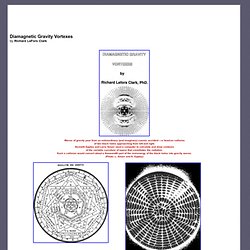
Kenneth Eppley and Larry Smarr used a computer to calculate and draw contours of the variable curvature of space that constitutes the radiation. Such a collision would convert about a thousandth part of the rest-energy of the black holes into gravity waves. (Photo: L. THE EARTH GRID, HUMAN LEVITATION AND GRAVITY ANOMALIES Knowledge of the Earth Grid or "crystalline Earth" is very ancient and has been utilized by a number of civilizations. While the subject of the Earth Grid has by now been covered in a considerable number of publications, one point in the Grid, marked by a long and strange history, at the eastern tip of Lake Ontario, is worth special mention. Daniel Home is the world famous levitator of the 19th century who lived in this Lake Ontario Grid point area.
Diagram 8 and 9. Gravitation. Gravitation, or gravity, is a natural phenomenon by which all physical bodies attract each other.
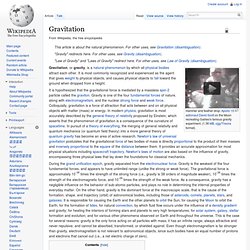
It is most commonly recognized and experienced as the agent that gives weight to physical objects, and causes physical objects to fall toward the ground when dropped from a height. During the grand unification epoch, gravity separated from the electronuclear force. Gravity is the weakest of the four fundamental forces, and appears to have unlimited range (unlike the strong or weak force). The gravitational force is approximately 10-38 times the strength of the strong force (i.e., gravity is 38 orders of magnitude weaker), 10-36 times the strength of the electromagnetic force, and 10-29 times the strength of the weak force. As a consequence, gravity has a negligible influence on the behavior of sub-atomic particles, and plays no role in determining the internal properties of everyday matter.
Universe. There are many competing theories about the ultimate fate of the universe.
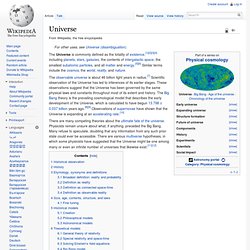
Physicists remain unsure about what, if anything, preceded the Big Bang. Many refuse to speculate, doubting that any information from any such prior state could ever be accessible. There are various multiverse hypotheses, in which some physicists have suggested that the Universe might be one among many or even an infinite number of universes that likewise exist.[11][12] Historical observation XDF size compared to the size of the Moon – several thousand galaxies, each consisting of billions of stars, are in this small view. XDF (2012) view – each light speck is a galaxy – some of these are as old as 13.2 billion years[13] – the visible Universe is estimated to contain 200 billion galaxies.
XDF image shows fully mature galaxies in the foreground plane – nearly mature galaxies from 5 to 9 billion years ago – protogalaxies, blazing with young stars, beyond 9 billion years. History Etymology, synonyms and definitions. Cosmos. Cosmos is the Universe regarded as an ordered system.[1] The philosopher Pythagoras is regarded as the first person to apply the term cosmos (Greek κόσμος) to the order of the Universe.[2] Cosmology[edit] Cosmology is the study of the cosmos in several of the above meanings, depending on context.
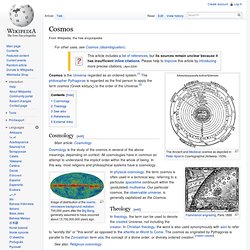
All cosmologies have in common an attempt to understand the implicit order within the whole of being. In this way, most religions and philosophical systems have a cosmology. In physical cosmology, the term cosmos is often used in a technical way, referring to a particular spacetime continuum within the (postulated) multiverse. LifeNetHome.org. Earth View. Wormholes. I was at a talk the other night listening to a nervous grad student present a paper about knots when, for whatever reason – I was thinking about Michael Heizer – wham!
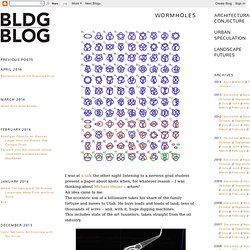
An idea came to me: The eccentric son of a billionaire takes his share of the family fortune and moves to Utah. He buys loads and loads of land, tens of thousands of acres – and, with it, huge digging machines. This includes state of the art tunnelers, taken straight from the oil industry. [Image: Create 3D].